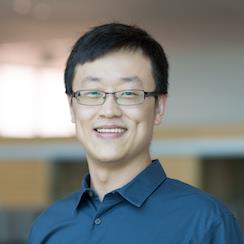报告题目:Novel Segmentation and Quantification Methods for CT-based COVID-19 Diagnosis and Prognosis
报告时间:2021年6月22日 13:00-15:00
报告地点:吉林大学中心校区计算机楼A521
报 告 人:高欣 教授
报告人简介:
 高欣,博士,现任沙特阿卜杜拉国王科技大学(KAUST)计算机科学系教授,并担任KAUST计算生物学研究中心副主任、KAUST智慧健康中心副主任、KAUST结构和功能生物信息学研究小组负责人。先后于2004年在清华大学计算机系获得学士学位,2009年在加拿大滑铁卢大学计算机学院获得博士学位。2009年10月至2010年9月,在美国卡耐基梅隆大学计算机学院雷恩计算生物学中心担任雷恩学者。高欣博士的研究焦点主要集中在计算机科学与生物学的交叉领域。在计算机科学领域,他领导的研究团队主要致力于开发与深度学习、概率图形模型、内核方法和矩阵分解相关的机器学习理论和方法。在生物信息学领域,他的研究团队主要致力于构建计算模型、研发机器学习技术、设计高效的算法,以解决从生物序列分析到三维结构确定,到功能注释,再到了解和控制复杂生物网络中的分子行为,以及最近的生物医疗和健康领域中的关键开放问题。在Nature Communications、Nature Catalysis、PNAS、NAR、PLOS Computational Biology、Bioinformatics、TPAMI、TNNLS、ISMB、RECOMB、ICLR、IJCAI、AAAI、KDD等国际重要期刊和会议上发表论文250余篇,同时担任Genomics,Proteomics & Bioinformatics、BMC Bioinformatics、Quantitative Biology、IEEE/ACM Transactions on Computational Biology and Bioinformatics等期刊的副主编,以及Methods和Frontiers in Molecular Bioscience等期刊的客座主编。(实验室网页:https://sfb.kaust.edu.sa)
高欣,博士,现任沙特阿卜杜拉国王科技大学(KAUST)计算机科学系教授,并担任KAUST计算生物学研究中心副主任、KAUST智慧健康中心副主任、KAUST结构和功能生物信息学研究小组负责人。先后于2004年在清华大学计算机系获得学士学位,2009年在加拿大滑铁卢大学计算机学院获得博士学位。2009年10月至2010年9月,在美国卡耐基梅隆大学计算机学院雷恩计算生物学中心担任雷恩学者。高欣博士的研究焦点主要集中在计算机科学与生物学的交叉领域。在计算机科学领域,他领导的研究团队主要致力于开发与深度学习、概率图形模型、内核方法和矩阵分解相关的机器学习理论和方法。在生物信息学领域,他的研究团队主要致力于构建计算模型、研发机器学习技术、设计高效的算法,以解决从生物序列分析到三维结构确定,到功能注释,再到了解和控制复杂生物网络中的分子行为,以及最近的生物医疗和健康领域中的关键开放问题。在Nature Communications、Nature Catalysis、PNAS、NAR、PLOS Computational Biology、Bioinformatics、TPAMI、TNNLS、ISMB、RECOMB、ICLR、IJCAI、AAAI、KDD等国际重要期刊和会议上发表论文250余篇,同时担任Genomics,Proteomics & Bioinformatics、BMC Bioinformatics、Quantitative Biology、IEEE/ACM Transactions on Computational Biology and Bioinformatics等期刊的副主编,以及Methods和Frontiers in Molecular Bioscience等期刊的客座主编。(实验室网页:https://sfb.kaust.edu.sa)
报告内容简介:
COVID-19 has caused a global pandemic and become the most urgent threat to the entire world. Tremendous efforts and resources have been invested in developing diagnosis, yet the pandemic is still undergoing.
Despite the various, urgent advances in developing artificial intelligence (AI)-based computer-aided systems for CT-based COVID-19 diagnosis, most of the existing methods can only perform classification, whereas the state-of-the-art segmentation methods require high levels of human intervention. In this talk, I will introduce our work on a fully-automatic, rapid, accurate, and machine-agnostic method that can segment and quantify the infection regions on CT scans from different sources. Our method is founded upon three innovations: 1) An embedding method that projects any arbitrary CT scan to a same, standard space, so that the trained model becomes robust and generalizable; 2) The first CT scan simulator for COVID-19, by fitting the dynamic change of real patients’ data measured at different time points, which greatly alleviates the data scarcity issue; and 3) A novel deep learning algorithm to solve the large-scene-small-object problem, which decomposes the 3D segmentation problem into three 2D ones, and thus reduces the model complexity by an order of magnitude and, at the same time, significantly improves the segmentation accuracy. Comprehensive experimental results over multi-country, multi-hospital, and multi-machine datasets demonstrate the superior performance of our method over the existing ones and suggest its important application value in combating the disease. I will finally introduce our ongoing work on developing full interpretable AI models to “see the unseen” from the CT scans of COVID-19 survivors to diagnose the long-term sequela of COVID-19.
主办单位:吉林大学计算机科学与技术学院
吉林大学软件学院
吉林大学计算机科学技术研究所
符号计算与知识工程教育部重点实验室
仿真技术教育部重点实验室
网络技术及应用软件教育部工程研究中心
吉林大学国家级计算机实验教学示范中心